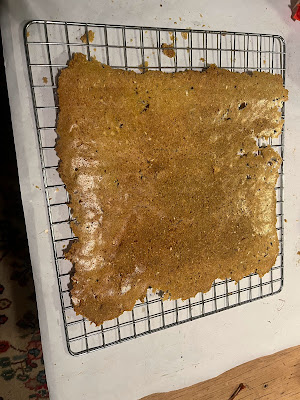Our 2023 garlic crop started by planting 1,100 cloves in early October, 2022.
They emerged from the ground by November and weathered through the winter snow.
After removing the garlic scapes during May and June, harvesting began the first week of July.
A strip down the middle of the patch was harvested first to make room for a row of Delicata squash.
The rest of the garlic were dug and hung to dry in bunches of 25 inside the garage. Total weight of peeled garlic: around 100 pounds. Every week through November I delivered two pounds of peeled garlic to cooks at a local homeless shelter. In October I processed around ten pounds into powder and granules. And yesterday I began processing more.
To preserve garlic, we grind it in a food processor, dehydrate it and grind it again into powder and granules.
10.75 pounds of garlic mash was spread on 10 teflon sheets and dried for around ten hours at 135 degrees.
Teflon sheets were then peeled off and the now rigid garlic shingles were dried another seven hours to remove moisture trapped against the film.
The 4.85 pounds of garlic crackers were again ground in the food processor, having lost 55% in dehydration.
The teflon sheets were also dried overnight so stuck on bits of garlic could be scraped off.
After grinding, garlic powder was separated from granules by shaking in a strainer which was then dumped into a colander. Larger bits were then dumped back into the food processor.
The desired result was roughly equal amounts of garlic powder and granules. To change the ratio: simply alter the time larger pieces spend in the processor.

Dry garlic stores great in jars: the powder we use in sauces and marinades, granules we add in recipes that get cooked which softens them. It's way quicker and easier to add dried garlic than processing fresh garlic when cooking!










